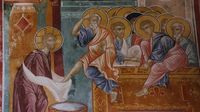On April 17, 2025, Christians around the world commemorate Holy Thursday, a significant day in the liturgical calendar that marks the beginning of the Paschal Triduum, a period that culminates in the celebration of Easter Sunday. This day is particularly important as it recalls the Last Supper of Jesus with his disciples, during which he instituted the sacrament of the Eucharist and the ordained ministry.
The Mass of the Lord's Supper takes center stage on this day, renewing the Eucharistic sacrifice established by Jesus. As part of the liturgy, the washing of the feet is performed, symbolizing Jesus's act of humility and service when he washed the feet of his apostles. This ritual serves as a powerful reminder of the call to serve one another with love and dedication.
During the Last Supper, Jesus took bread, blessed it, and broke it, saying, "This is my body," and similarly took a cup of wine, declaring, "This is my blood of the covenant." These actions not only instituted the Eucharist but also reinforced the bond of community among the faithful, inviting them to remember Him through this sacred rite. As the article notes, this moment is not just a historical recollection but a living tradition that continues to resonate in the hearts of believers.
In a homily delivered during Holy Thursday in the Year 2000, Cardinal Carlo M. Martini reflected on the significance of these gestures. He emphasized that when Jesus placed a piece of bread in the hands of his disciples, he was saying, "I am with you, I trust you, and I entrust myself to you." This profound act of trust invites believers to embrace a life of service, mirroring the humility exhibited by Christ.
The washing of the feet, a central element of Holy Thursday, is a liturgical act that symbolizes the essence of Christian service. In many Catholic churches, the priest washes the feet of twelve individuals, representing the apostles. This ritual not only commemorates Jesus's humility but also serves as a call to action for the faithful to embody the same spirit of service in their daily lives.
Furthermore, the tradition of visiting the Sepulchres follows the Mass, where believers pray before the altars that hold the Eucharist, symbolizing Christ's presence. This act of vigilance and prayer reflects the anticipation of the Passion of Christ, which is observed on Good Friday. The Sepulchres, often adorned with flowers and candles, provide a serene space for reflection and meditation on the sacrifices made by Jesus.
Holy Thursday also serves as a reminder of the multifaceted reality of the Church, encompassing various ministries and charisms, all centered on Christ. The teachings of the Second Vatican Council highlight the relationship between the common priesthood of the faithful and the ministerial priesthood, emphasizing that both are essential to the life of the Church.
As the evening progresses, the liturgy transitions into a time of reflection on the themes of love, service, and humility. The actions of Jesus during the Last Supper disrupt conventional ideas of religious certainty, introducing a new liturgical language that emphasizes the importance of serving one another.
The significance of the washing of the feet extends beyond the ritual itself; it embodies a universal message of love and humility. In a world often marked by division and selfishness, this act serves as a powerful reminder of the importance of serving others, following the example set by Jesus.
Local traditions in Italy further enrich the observance of Holy Thursday. In Calabria, for instance, a priest may wash the feet of twelve individuals seated around a table, symbolizing the Last Supper. In Enna, Sicily, after the Mass, it is customary for the faithful to visit at least seven churches, a practice that fosters community and spiritual reflection.
The Triduum Pasquale, which spans from the evening of Holy Thursday to Easter Sunday, encapsulates the heart of the Christian liturgical year. Each day carries its own significance, with Holy Thursday focusing on the Last Supper, Good Friday commemorating the Passion and death of Jesus, and Holy Saturday serving as a day of silence and anticipation before the Easter Vigil.
As believers engage in these sacred rituals, they are reminded of the profound mystery of faith that accompanies the Eucharist. The bread and wine, transformed into the body and blood of Christ, invite the faithful to partake in a divine communion that transcends time and space.
In the words of Cardinal Martini, the act of washing the feet not only signifies Jesus's love but also calls believers to recognize their own capacity for humility and service. This gesture invites individuals to embrace the challenges of life with faith and courage, fostering a deeper connection with God and one another.
Ultimately, Holy Thursday serves as a pivotal moment in the Christian calendar, inviting believers to reflect on their own lives and the ways in which they can embody the teachings of Christ. As they gather to celebrate the Eucharist, wash one another's feet, and visit the Sepulchres, they are reminded of the call to live a life of service, love, and humility, following the example of their Lord.







